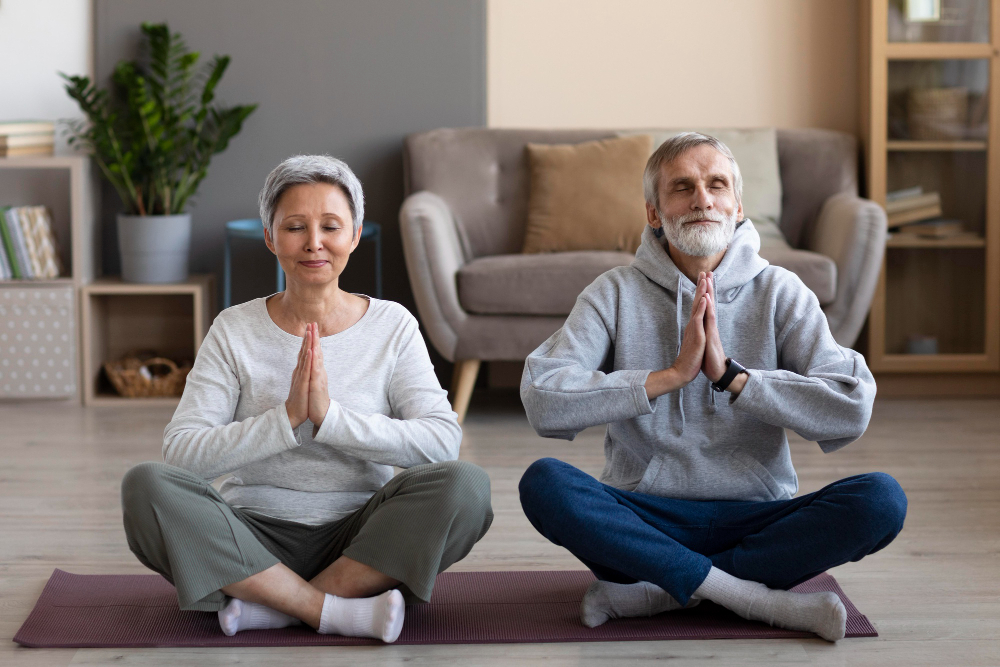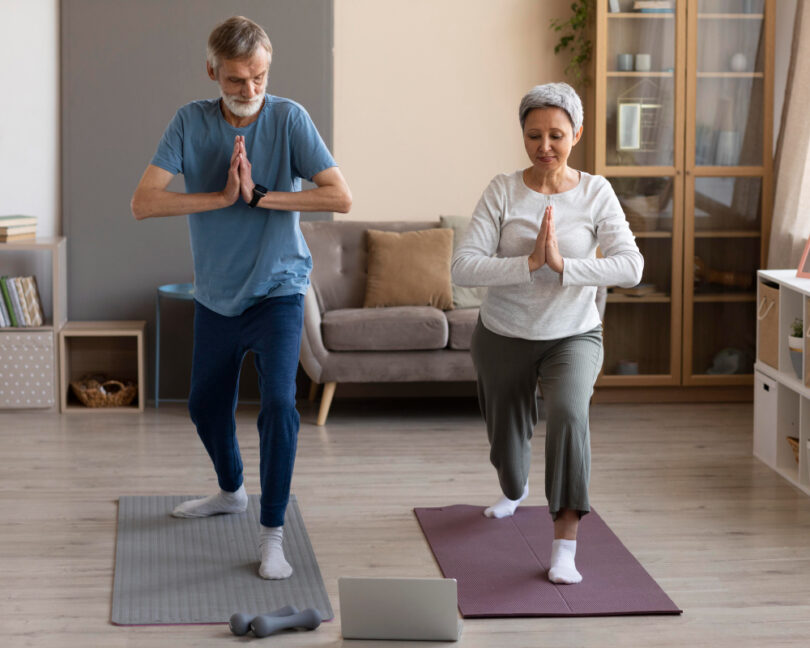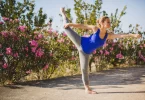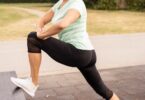Yoga near me for seniors is more than just a search term; it’s a gateway to improved wellness and longevity. Yoga offers numerous benefits for seniors, including enhanced flexibility, increased muscle strength, and better mental clarity. This guide helps seniors find local yoga classes tailored to their needs, ensuring a safe and beneficial practice.
Table of Contents
Why Yoga is Ideal for Seniors
Yoga is a transformative practice that offers numerous benefits, especially for seniors seeking to enhance their flexibility, strength, and mental clarity. If you’re looking to start Yoga or find new classes nearby, this guide will help you discover the best yoga classes for seniors in your area.
Types of Yoga Suitable for Seniors
Yoga can be a fantastic way for seniors to maintain flexibility, strength, and mental well-being. Here are several types of Yoga that are particularly suitable for seniors:
- Hatha Yoga: Hatha Yoga is among the most accessible forms for beginners and seniors. It focuses on physical postures and breathing techniques, and its slow pace allows careful alignment and attention to breathing.
- Iyengar Yoga: Known for using props like blocks, straps, and chairs, Iyengar Yoga helps seniors achieve correct pose alignment. This support makes participating safely easier for those with limited mobility or balance issues.
- Chair Yoga: Specifically designed for those who may have difficulty standing for long periods or getting up and down from the floor, chair yoga modifies traditional Yoga poses to be done while seated or using a chair for support.
- Restorative Yoga: This type of Yoga uses props to support the body in poses for several minutes. The aim is to relax into the posture, allowing for gentle stretching and relaxation. It’s excellent for reducing stress and improving flexibility.
- Gentle Yoga: Gentle Yoga is a softer approach focusing on slow stretches, flexibility, and deep breathing. It is less strenuous than other types and is excellent for seniors looking to maintain mobility and reduce stress without overexertion.
- Tai Chi Yoga: Though not traditional Yoga, Tai Chi incorporates similar gentle movements and breathing control principles. It is often referred to as “meditation in motion” and is beneficial for balance, flexibility, and mental focus.
Each of these types of Yoga offers unique benefits and can be adapted to seniors’ individual needs and limitations, making Yoga a highly versatile and beneficial exercise for aging adults.
Finding the Right Yoga Class
Finding a suitable yoga class is essential for seniors to ensure they get the most benefit while minimizing the risk of injury. Here are some steps and tips to help seniors find a yoga class that suits their needs:
- Assess Your Needs: Evaluate what you hope to achieve with Yoga. Are you looking for flexibility, strength, balance, or a way to manage stress? Knowing your goals can help you choose the right type of Yoga.
- Consult with a Healthcare Provider: Before starting any new exercise program, it’s wise to consult with a healthcare provider, especially if you have existing health issues. They can offer advice on what types of activities are safe and beneficial.
- Look for Beginner or Senior Classes: Many yoga studios and community centers offer classes specifically designed for seniors or beginners. These classes usually focus on gentle movements, flexibility, and balance.
- Check the Instructor’s Credentials: Ensure the yoga instructor is certified and has experience working with seniors. Experienced instructors can modify poses and offer appropriate support.
- Visit the Class Before Joining: If possible, visit a class to observe. Check if the pace and the activities suit your ability level. Notice if the instructor is attentive and whether they assist students with modifications.
- Ask About Props and Support: Inquire whether the class provides props like chairs, blocks, straps, and mats. These can be helpful, especially if you have limited mobility or balance issues.
- Consider the Class Size: Smaller class sizes often mean more personalized attention. Ensure the class size is manageable, so the instructor can monitor and assist all participants effectively.
- Look for Accessibility: Ensure the location is easily accessible. Consider factors like parking, public transport options, and whether the facility is wheelchair-friendly.
- Trial Classes: Many studios offer trial classes at a reduced rate or even free. Taking a trial class can help you decide if the yoga style, instructor, and environment are right for you.
- Online Options: If mobility or transport is a concern, consider online yoga classes. Many websites and apps offer sessions designed specifically for seniors, which can be done from home.
Finding the right yoga class as a senior is crucial for ensuring the experience is both enjoyable and beneficial. Here are some resources and tips for finding senior-friendly yoga classes:
- Senior-Friendly Yoga Retreats: These retreats offer a more immersive experience, often with tailored programs to suit the needs of older adults.
- Chair Yoga Classes: Perfect for those with limited mobility, chair yoga modifies traditional poses to be performed while seated, providing a safe and accessible option.
Preparing for Your First Yoga Class
Preparing for your first yoga class as a senior can make the experience more enjoyable and beneficial. Here are some tips to help you get ready:
- Choose Appropriate Clothing: Wear comfortable, loose-fitting clothing that allows you to move freely. Yoga is performed in bare feet, so shoes aren’t necessary, but you might want to wear socks until you’re on your mat.
- Bring the Right Equipment: Most studios provide yoga mats, but you might prefer to bring your own for hygiene and comfort. Consider also bringing a water bottle; if you have one, your props like a yoga block or strap to help with stretches.
- Arrive Early: Try to arrive at least 15 minutes before the class starts. This gives you time to sign in, meet the instructor, find a spot where you feel comfortable, and settle in. Arriving early also allows you to let the instructor know about any health issues or concerns you might have.
- Communicate with Your Instructor: Before the class begins, introduce yourself to the instructor. Inform them of any physical limitations or health conditions you have. They can offer modifications and watch out for your safety during the class.
- Start with a Beginner or Senior Class: If it’s your first time practicing Yoga, consider starting with a beginner or senior-specific class. These classes move slower and focus on the fundamentals of Yoga, making it easier to follow along.
- Listen to Your Body: Yoga is not supposed to be painful. If you feel pain, gently ease out of the pose. Focus on what you can do, not on what others are doing. Yoga is a personal practice, and listening to your body and adjusting as needed is essential.
- Stay Hydrated: Drink plenty of water before and after your class to stay hydrated. You can also bring a water bottle to the class to sip.
- Have No Expectations: Go into your first class with an open mind and no expectations. Yoga is a practice that develops over time, and every day can be different. Enjoy the journey and focus on the present moment.
- Practice Patience and Persistence: Feeling comfortable with the class’s poses and flow might take a few sessions. Keep an open mind and give yourself grace as you learn and grow in your practice.
- Enjoy the Experience: Yoga is about improving flexibility and strength and finding relaxation and peace. Enjoy the time you’ve set aside for yourself, and try to carry the calmness you achieve during Yoga into the rest of your day.
Benefits of Regular Yoga Practice
Regular Yoga offers a wide range of physical, mental, and emotional benefits, precious as we age. Here are some of the key benefits of maintaining a regular yoga routine:
- Improved Flexibility and Mobility: Yoga gently stretches your muscles, ligaments, and tendons, helping to improve flexibility and reduce stiffness. Over time, you might find it easier to reach things on high shelves, tie your shoes, or perform other daily activities.
- Enhanced Strength and Balance: Many yoga poses build strength in the major muscle groups, such as the arms, legs, back, and core. This increased strength can help prevent falls—a primary concern for seniors—by improving balance and coordination.
- Better Joint Health: Yoga can help maintain joint health and may reduce arthritis symptoms by keeping joints through a range of motions. This can also help alleviate joint pain and stiffness.
- Increased Circulation: Yoga helps improve blood circulation, speeding up recovery from injuries and helping cells receive more oxygen and nutrients. This improved circulation can also help reduce swelling and improve heart health.
- Stress Reduction and Improved Mental Health: Yoga encourages relaxation, mindfulness, and focus, which can help to reduce stress and anxiety. Regular practice is often associated with better mood, more resilience, and a positive outlook on life.
- Enhanced Breathing: Yoga significantly emphasizes breathing techniques that can enhance lung capacity and improve respiratory function. This is especially beneficial as lung efficiency tends to decline with age.
- Pain Relief: Yoga can effectively alleviate various types of pain, including back pain, neck pain, and pain from conditions like arthritis. The gentle stretching and strengthening exercises can be therapeutic.
- Improved Digestion: Yoga’s movements and stretches can help facilitate smoother digestion and alleviate constipation, which can be an issue for seniors.
- Better Sleep: Regular yoga practice has been shown to help people fall asleep quicker, sleep longer, and return to sleep more quickly if they wake up in the middle of the night. This is likely due to Yoga’s ability to help people relax and reduce stress.
- Increased Mind-Body Connection: Yoga helps raise awareness of the present moment and encourages mindfulness, improving concentration and a heightened sense of physical and emotional well-being.
By integrating Yoga into your daily or weekly routine, you can enjoy these benefits and contribute significantly to maintaining and improving your quality of life as you age.
Success Stories

Here are a couple of inspiring stories from senior yoga classes showcasing the positive impact yoga can have at any age:
Story 1: Joan Finds Renewed Vitality
Joan, a 72-year-old retiree, initially joined a senior yoga class on the recommendation of her doctor to help manage her arthritis and improve her overall mobility. Initially skeptical, Joan found the first few sessions challenging but was encouraged by her instructor’s patient guidance and the welcoming community. Over the months, she noticed significant improvements in her physical health, mental clarity, and emotional well-being. Yoga became a crucial part of her weekly routine. She shared that Yoga gave her a new sense of vitality and a renewed ability to enjoy activities with her grandchildren, which she thought were a thing of the past.
Story 2: Bill’s Journey Back from Isolation
After losing his wife, Bill, aged 78, became increasingly isolated. His daughter suggested he join a yoga class to interact with others while keeping active. Reluctant at first, Bill soon found that the gentle movements helped ease his chronic back pain, which had worsened due to long hours of sitting alone at home. More importantly, the class helped him reconnect with his peers, fostering new friendships centered around a shared interest in health and wellness. Bill expressed that the class helped him physically and brought him out of his shell, making him feel connected and part of a community again.
Story 3: Margaret’s Balance Improvement
Margaret, at 65, was terrified of falling and injuring herself, a fear that kept her from enjoying walks in her neighborhood. After joining a yoga class designed for seniors, she worked on poses that improved her balance and strength. Within several months, Margaret was more confident in her physical abilities. Still, she had also started walking more frequently, using the breathing techniques she learned in Yoga to keep her calm and focused. She proudly shared with her class how these walks had become a cherished part of her day, attributing her improved confidence and mobility to her yoga practice.
These stories reflect the transformative power of Yoga, showing how it can significantly enhance the quality of life for seniors by improving physical health, providing emotional support, and building community connections. Each participant can find personal growth and satisfaction through their practice regardless of when they start.
FAQs
Which type of Yoga is best for seniors?
The best type of Yoga for seniors typically includes gentler, more accessible forms that focus on flexibility, balance, and relaxation. Hatha Yoga and Chair Yoga are highly recommended due to their slower pace and emphasis on correct alignment. Iyengar Yoga, which uses props to achieve postures, is also excellent, particularly for those with physical limitations. Restorative Yoga can be particularly beneficial for those interested in reducing stress and improving overall well-being.
Is 70 too old to start Yoga?
No, 70 is not too old to start Yoga! Yoga is highly adaptable and can be started at any age. Many seniors begin Yoga later in life and reap significant benefits, including improved mobility, better balance, reduced pain, and enhanced mental clarity. It’s always a good idea to start with classes designed for seniors or beginners and consult a healthcare provider before beginning any new exercise regimen.
How often should a 60-year-old do Yoga?
The frequency of yoga practice can vary based on individual fitness levels, health conditions, and personal goals. However, a general recommendation for seniors starting is to aim for 2-3 weekly sessions. This frequency allows the body to acclimate to new movements, reduces the chance of injury, and provides time for recovery. Over time, if desired and as fitness improves, the frequency or duration of sessions can be increased.
Is 28-day yoga for seniors free?
The availability and cost of programs like a “28-day yoga for seniors” can vary. Some online platforms or local community centers might offer free introductory yoga programs or trial periods, while others might charge for access. You would need to check with specific providers or platforms providing such a program to confirm if they have a free option or if there is a cost involved.
Conclusion
Yoga is a beneficial and adaptable form of exercise for seniors. It offers a pathway to improved health and a more vibrant life in older age. Start exploring yoga classes near you today!







